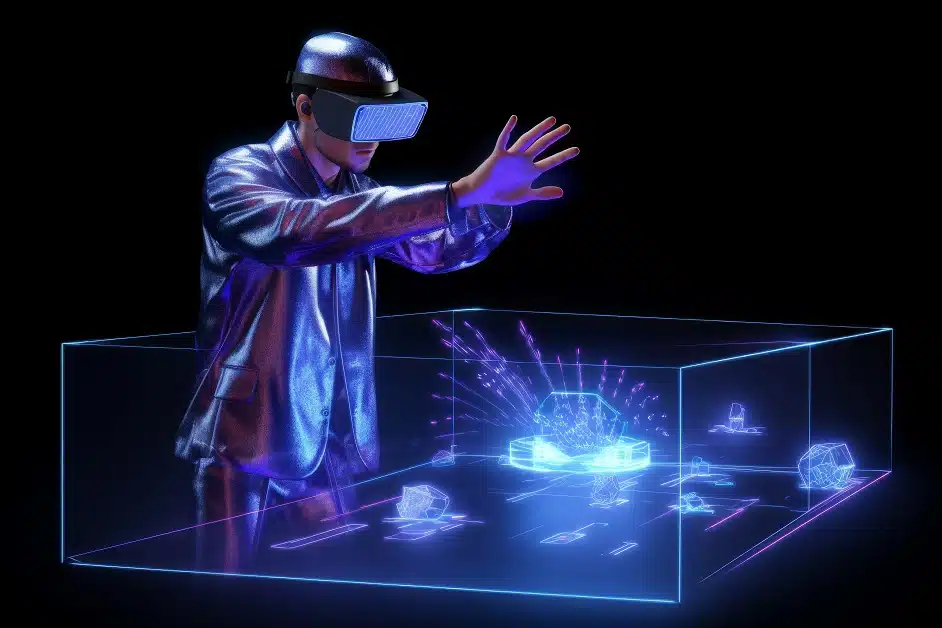Augmented Reality (AR) has appeared as one of the most transformative technologies in recent years, allowing the combination of digital content with the physical world to create interactive and exceptional experiences. The scope of Augmented Reality extends across different domains, including healthcare, education, gaming, retail, real estate, and various other fields.
Augmented Reality rendering involves overlaying content of digital, including 3D models, animations, and images, onto the physical environment in real-world and it is accomplished through various devices like tablets, smartphones, and AR glasses that utilize sensors and cameras to capture the surroundings of the world and integrate digital elements with it.
Augmented Reality allows to capture of physical data and effectively feeds it into the AR system. It integrates and processes content of digital with live camera feeds to make a coherent augmented experience and it enables the delivery of the augmented content to the user, which includes tablets, AR glasses, smartphones, tablets, and headsets.
In this article, we are going to analyze the scope of augmented reality, including its comprehensive range of applications and AR rendering potential, which allows us to emphasize how it improves user experiences and delivers innovative solutions in various fields.
Applications: Augmented Reality
Entertainment and Gaming:
AR has effectively revolutionized the entertainment and gaming industry by developing immersive experiences that combine the physical and virtual worlds.
Augmented Reality improves storytelling by letting users interact with narrative components in their real space which makes narratives more personalized and engaging.
Meanwhile, games like “Pokémon GO” have shown AR’s possibility for interactive play in physical-world environments. Every player can see virtual creatures that occur in their real-world surroundings which improves social interaction and engagement.
Training and Education:
AR renderings deliver transformative possibilities for training services and education by providing interactive and experiential learning environments.
Augmented Reality delivers real simulations for training. AR can simulate surgical processes or anatomy which offers hands-on practice without physical hazards in fields like medicine.
AR applications allow to overlay the content of education on real-world objects which makes abstract ideas more tangible. For example, students related to bio can view 3D models of organs or cellular structures superimposed on their books.
Retail and E-Commerce:
AR rendering, in retail, improves the experience of shopping by letting customers interact with products innovatively.
AR allows virtual try-ons for accessories, cosmetics, and especially clothing which allows customers to see how products would wear them in real work. It features lessened return rates and improves satisfaction of the customer.
AR assists the visualization of the customer of how appliances, decor items, or furniture would look in their house, and its ability helps in creating well-informed purchase decisions and reduces purchase hesitation.
Healthcare:
AR rendering has a noteworthy essence for healthcare which allows for enhancing both patient care and medical training.
AR is utilized by surgeons to overlay vital information which includes patient anatomy or real-time imaging, directly onto their field of view during procedures which allows for enhanced precision and lessens the hazard of blunders.
AR delivers interactive simulations and visualizations to medical professionals and students which allows them to streamline more practical learning and practice in intricate medical scenarios.
Real Estate and Architecture:
AR rendering delivers inventive manners to offer and visualize designs and properties in real estate and architecture.
AR allows forthcoming buyers to bring virtual tours of properties with overlaying information about features and luxuries directly onto their view of the property which allows to improves the property viewing experience and assists in quick decision-making.
AR is used by architects for architectural virtualization by overlaying building design 3D models onto physical sites. This enables stakeholders and clients to visualize how a future structure will integrate into its environment before construction begins.
Navigation and Wayfinding:
AR rendering enables improved navigation and wayfinding by delivering real-time suggestions and details.
AR apps can overlay real-time updates, points of interest, and directions onto the view of users of the environment. It features enhanced navigation in intricate environments like cities or large campuses.
AR can guide users to their destinations by overlaying arrows of direction and information onto the physical space in indoor environments like shopping malls or airports.
Manufacturing and Maintenance:
AR rendering allows simplification and streamlining of effective processes and enhances efficiency.
AR delivers gradual instruction of visualization for forming or strengthening equipment. While working, technicians can view overlayed guidance and interactive elements while working, reducing errors and improving efficiency.
AR allows remote professionals to deliver real-time service by overlaying diagnostic information or instructions onto the technician’s view which allows to facilitate quicker problem-solving and lessening downtime.
Future Innovations: Augmented Reality
Advance Hardware:
AR rendering upcoming future will be shaped by hardware advancements which include sophisticated headsets and AR glasses with enhanced processing power, improved comfort, and better display quality.
Integration with AI:
Integration of AR with artificial intelligence (AI) and machine learning will improve the AR rendering abilities. AI enables to enhancement of contextual understanding, object recognition, and personalization which makes AR experiences more adaptive and intellectual.
Applications Expand:
As gradually AR evolves day by day, it expands applications into new industries and various fields. AR innovations will possibly impact different areas which include social media, tourism, and beyond which showcase new methods to experience and interact with the world.
Interactivity:
AR experiences in the future will deliver significant interactivity, with more sophisticated haptic feedback, voice control, and gesture recognition. These enhancements will allow us to make experiences of utilizing AR more immersive and intuitive.
Conclusion
Augmented Reality (AR) rendering scope is extensive and constantly extending which allows it to deliver transformative advantages across a broad range of applications. From improving education and entertainment to revolutionizing healthcare and retail, AR rendering delivers innovative solutions and exceptional experiences that were difficult at one time.
Assuming AR rendering scope can lead to great enhancements in different fields that deliver improved user experiences, novel applications, and streamlined processes that allow us to push the boundaries.



